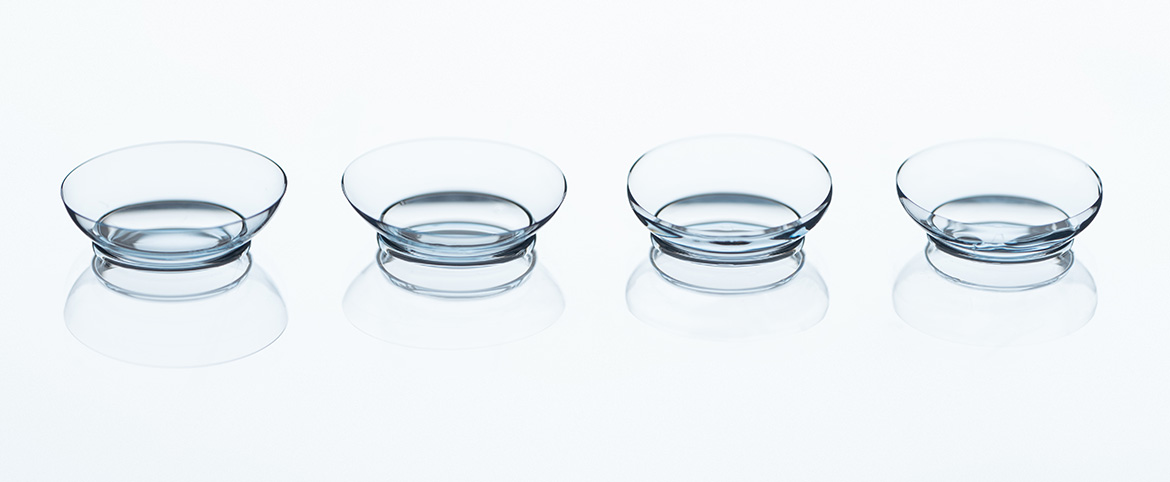



Gaz permeable lenses, also known as hard lenses or flexible lenses, are tailor-made and guarantee excellent oxygenation of the cornea.
Easier to handle than soft contact lenses and presenting less risk of infection in case of negligence, these lenses offer a high level of safety in use, which is why they are recommended for children. As the visual quality obtained with a gaz permeable lens is often better than with a soft lens, these lenses are recommended for strong corrections and severe astigmatism.
They are also suitable for irregular corneas such as in patients with keratoconus. These lenses should be replaced every 18 months (or every 12 months for children and young people under the age of 25) and require daily care.
Lenses are medical devices whose fitting, issuing and follow-up care require the skills of specialized healthcare professionals. Only these professionals can guarantee the expert advice and check-ups required for long-term wear. It is up to the prescriber to choose the type of lens and the replacement schedule, taking into account the optical and physiological needs that vary from wearer to wearer.
Myopia is an ametropia which occurs when the eyeball is too long or the cornea is too curved, resulting in a greater distance between the cornea and the retina. A myopic patient can see close-up objects clearly, but not distant objects because the image is formed in front of the retina, rather than directly on its surface.
Hypermetropia, on the other hand, occurs when the eyeball is too short or the cornea is insufficiently curved, meaning that the image is formed behind the retina and requires a permanent effort of focusing in distance vision but even more so in near vision.
• Material: Boston XO2, Optimum 125
• Daily wear
• Care solutions : Hydrogen peroxide solution, Deproteinizing solution
• Mailer
ro : 7.20 to 8.60 by 0.05 mm
ØT : 9.00 to 11.10 by 0.30 mm
Sph : Plano to -20.00 by 0.25D
• Material: Boston ES, EO, XO, XO2, Optimum 26, 65, 100, 125
• Daily wear
• Care solutions : Multipurpose solution, Deproteinizing solution
• Mailer
ro : 7.20 to 8.60 by 0.05 mm
ØT : 9.00 to 11.10 by 0.30 mm
Sph : -30.00 to +30.00 by 0.25D
• Material: Boston ES, EO, XO, XO2,
Optimum 26, 65, 100, 125
• Daily wear
• Care solutions : Multipurpose solution, Deproteinizing solution
• Mailer
ro : 7.20 to 8.60 by 0.05 mm
ØT : 9.00 to 10.20 by 0.30 mm
Sph : -25.00 to +25.00 by 0.25D
• Material: Boston ES, EO, XO, XO2, Optimum 26, 65, 100, 125
• Daily wear
• Care solutions : Multipurpose, Deproteinizing solution
• Mailer
ro : 7.20 to 8.60 by 0.05 mm
ØT : 8.50 to 11.00 by 0.50 mm
Sph : -25.00 to +25.00 by 0.25D
• Material: Optimum 100 and 125, Boston XO, XO2
Handling tint RE Purple / LE Blue
• Gaz permeable lenses
• Nighttime lenses
• Care solutions : Comfort drops, Hydrogen peroxide solution, Deproteinizing solution
• Individual lens in a mailer
ro : According to the need
ØT : 10.00 to 11.60mm
Myopia up to -7.00D
Hypermetropia up to +4.00D
Astigmatism up to -4.00D
Presbyopia (add=VL/2)
• Material: Optimum 100 and 125, Boston XO, XO2
Handling tint RE Purple / LE Blue
• Gaz permeable lenses
• Nighttime lenses
• Care solutions : Comfort drops, Hydrogen peroxide solution, Deproteinizing solution
• Individual lens in a mailer
ro : According to the need
ØT : 10.00 to 11.60mm
Myopia up to -4.00D
Astigmatism up to -4.00D
Astigmatism is an ametropia caused by an abnormality in the curvature of the cornea or lens, which instead of having the spherical shape of a tennis ball is more like that of a rugby ball. The light can no longer focus on the retina and the image is blurred up-close and in the distance.
“Toric lenses” are designed to correct astigmatism.
• Material: Boston XO2, Optimum 125
• Daily wear
• Care solutions : Hydrogen peroxide solution, Deproteinizing solution
• Mailer
ro : 7.20 to 8.60 by 0.05 mm
ØT : 9.00 to 11.10 by 0.30 mm
Sph : Plano to -20.00 by 0.25D
Cyl : TI = -1.50 to -8.00 by 0.25D
TE = -0.75 to -4.00 by 0.25D
• Material: Boston ES, EO, XO, XO2, Optimum 26, 65, 100, 125
• Daily wear
• Care solutions : Multipurpose solution, Deproteinizing solution
• Mailer
ro : 7.20 to 8.60 by 0.05 mm
ØT : 9.00 to 11.10 by 0.30 mm
Sph : -20.00 to +10.00 by 0.25D
Cyl : -0.75 to -4.00 by 0,25D
• Material: Boston ES, EO, XO, XO2 and Optimum 26, 65, 100, 125
• Daily wear
• Care solutions : Multipurpose solution, Deproteinizing solution
• Mailer
ro : 7.20 to 8.60 by 0.05 mm
ØT : 9.00 to 11.10 by 0.30 mm
Sph : -25.00 to +25.00 by 0.25D
Cyl : -1.50 to -8.00 by 0.25D
Presbyopia is a natural age-related process that usually develops in your 40s. The lens loses its flexibility and ability to focus on close-up objects. As experts in presbyopia, we have developed a unique know-how and state-of-the-art technology in the design and manufacture of contact lenses for presbyopes with and without astigmatism. Our solutions cater for all visual impairments associated with presbyopia (myopia, hypermetropia and/or astigmatism), and are available as monthly or quarterly soft lenses as well as hard lenses.
“Progressive lenses” or “multifocal lenses” are designed to correct presbyopia.
• Material: Boston ES, EO, XO, XO2, Optimum 26, 65, 100, 125
• Daily wear
• Care solutions : Multipurpose solution, Deproteinizing solution
• 1 unit
ro : 7.20 to 8.60 by 0.05 mm
ØT : 9.80 mm
Sph : -15.00 to +10.00 by 0.25D
Cyl : TI : -1.50 to -8.00 by 0.25D
TE : -0.75 to -2.00 by 0.25D
Add : +1.00 to +3.50 by 0.25D
• Material: ES, EO, XO, XO2, Optimum 65, 100, 125
• Daily wear
• Care solutions : Multipurpose solution, Deproteinizing solution
• 1 unit
ro : 7.20 to 8.60 by 0.05 mm
ØT : 8.50 to 10.00 by 0.50 mm
Sph : -15.00 to +10.00 by 0.25D
Cyl : TI : -1.50 to -8.00 by 0.25D
TE : -0.75 to -2.00 by 0.25D
Add : +1.00 to +3.50 by 0.25D
• Material: Boston ES, EO, XO, XO2, Optimum 26, 65, 100, 125
• Daily wear
• Care solutions : Multipurpose solution, Deproteinizing solution
• 1 unit
ro : 7.00 to 8.40 by 0.05 mm
ØT : 9.20 to 10.00 by 0.40 mm
Sph : -15.00 to +8.00 by 0.25D
Cyl : TE : -0.75 to -2.00 by 0.25D
Add : +1.50D / +2.00D / +2.50D / +3.00D